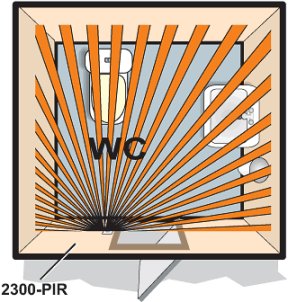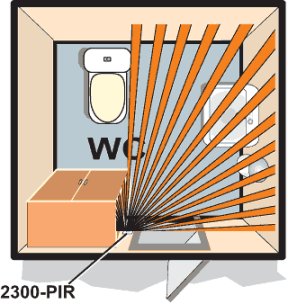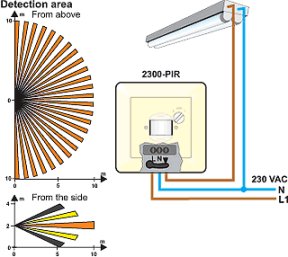8D. Toilet with IR detector
Relatively few visits per day, incandescent bulbs, 50 Hz or non-dimmable HF ballasts
| Premises
In small toilets and other small spaces it is usually difficult to justify investment in presence-controlled lighting. The investment cost using existing technology is too high in relation to the saving that can be made. In premises such as these, detection can be achieved with an IR detector fitted with a 180° lens and positioned where the light switch is normally located. Often the investment can be justified more easily by including other benefits in the costing, such as environmental savings and improvements in comfort. Future rises in energy costs, improvements in technology and falling costs of technology can also make it profitable to invest in lighting control by presence detection in smaller premises too. This example shows an installation in a toilet that is visited relatively infrequently, up to around 12 times per day. |
Light sources
This application shows an example with light fittings that are fitted with incandescent bulbs, 50 Hz coil ballasts or non-dimmable HF ballasts. Detector placement Various types of detectors are available on the market for mounting in pattresses in place of switches. Unfortunately the limitations of this type of detector and placement are poorly understood. The 2300-PIR detector replaces the switch by the door. This is not the best position for a passive infrared detector. It is only suitable in certain applications, such as toilets, where people come and go, where movement is readily detected and where the view of the detector is not obstructed by furniture or fittings. Here a cabinet is placed so that it obscures the sensor’s detection field! |
||||
|
|
|||||
| Control system
The light fittings are connected directly to the detector. Note the maximum permissible detector load (2300 VA, incandescent bulbs, resistive load). No more than two fluorescent light fittings should be connected directly to the detector. Use contactors for larger loads. See wiring diagram. Wiring example without contactors |

Wiring example with contactors See also applications 9A and 12A for presence detection control in small premises
|
||||










